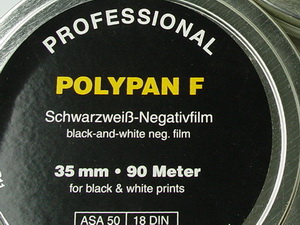Polypan F50 Review |
This is the cheapest film on the market by a large margin, but it's also probably the worst in quality. I shot several rolls using different cameras and lenses and developed them with various developers inclusing Rodinal, Fomadon LQN, Fomadon LQR, Paterson FX-39 and Kodak Microdol-X. The results were always sub-standard and ranged from awful (with Rodinal) to mediocre (with 1:3 Microdol-X).
The emulsion appears to be very thin which I think is why the tonality is so poor and possibly why it scratches so easily. Every roll, regardless of camera came out with fine thin scratches across them. I managed to get fairly nice tonality using Microdol-X at 1:3, but still sub-standard comapred to good films. The name has been chosen to allude to Ilford Pan F 50, and some claim it is the same emulsion on a thin polyester backing, but I can categorically state this is not the case and this film is vastly inferior to Pan F 50.
Film
Fact SheetASA 50 black and white neg film. User CommentsI didn't like it in Rodinal, a bit grainy for such a slow film. In Diafine (EI 50) it looks a bit better. I think the best match for it would be normal metol/phenidone/hydroquinone developers, like D-23, D-76 or Microphen. (varjag)
(Reviewed by Ian Greenhalgh) |



I used it very often for a while. As soon as you rate it 25 iso, it is better. I usually souped it in LC29 1+19 for 20 min, 1 shake every 3min. I enjoyed the nice grayscale you can have with it. You have to be gentle otherwise it can be pretty high in contrast and in that case, results are not so good. Keep the contrast "normal" for that film and everything will turn right i.e. don't overdevelop.
I usually print in the drakroom 30x40 cm and grain wasn't too high. Even 40x60 cm is still OK ( I don't stick my nose on the prints, it would leave traces :)
Something very desirable, it has no anti-halation layer so it yield a "halo" around highlights surronded by dark areas.
I wasn't using it for everything but for old time cameras, cars or abandonnned places, it is ideal...
Of course, for clinical "digital-like" results ...